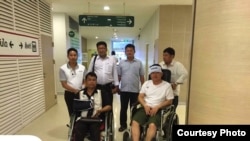Human Rights Watch and local rights groups condemned Monday’s attack on two opposition parliamentarians, who were dragged from their cars and beaten by an organized group of masked men.
Videos of the attacks on Nhay Chamroeun and Kong Saphea, members of the Cambodia National Rescue Party, quickly circulated on social media sites like Facebook, adding a new dimension to what Human Rights Watch characterized as old tactics of Prime Minister Hun Sen’s Cambodian People’s Party.
“Using a mob to attack opposition members of parliament sends a chilling signal to Cambodians that a new wave of political violence can be unleashed anytime and anywhere,” Brad Adams, Asia director at Human Rights Watch, said in a statement. “This ugly incident is the same kind of crude political violence used against the opposition in the 1990s to fend off challenges to Hun Sen’s one-party rule.”
Witnesses identified elements of Hun Sen’s bodyguard unit in civilian dress as “core participants” in demonstrations outside the National Assembly on Monday prior to the attacks, as well as in a demonstration outside the house of Rescue Party Vice President Kem Sokha, whose ouster was the purported aim of Monday’s anti-opposition protests.
“Observers also identified among the protesters non-uniformed members of units under the Phnom Penh municipal police, including regular and para-police, the latter commonly used as a shock-force against opposition gatherings,” Human Rights Watch said. “Many of the protesters told observers that they had come to Phnom Penh from Kandal province, where Hun Sen maintains his personal residence and his [bodyguard unit] is located.”
The call to remove Kem Sokha from his position was publicly backed by members of the ruling Cambodian People’s Party, including Kun Kim, head of the armed forces, and the head of the Cambodian police, Human Rights Watch said.
“Many of the demonstrators were wearing pieces of red cloth, a marker that CPP-controlled vigilantes in civilian clothes have operated with since at least January 2014, when they participated in the break-up of a peaceful opposition gathering at Phnom Penh’s ‘Democracy Plaza’ (also known as Freedom Park),” the group said. “Some were armed with slingshots, a weapon of choice for such forces for several years. Some were masked.”
Human Rights Watch linked Monday’s attack to a similar violence perpetrated by the CPP against the opposition in the 1990s, as documented by UN observers. Under such methods, “reaction forces present themselves as ordinary citizens enraged at the opposition, when they are in fact organized and sent into action by the CPP leadership,” Human Rights Watch said. “A repeated pattern during deployment of reaction forces has been for some elements to act in a particularly violent manner, while others stop at verbal abuse and threats.”
Local civil society groups, including the Cambodian Center for Human Rights, Adhoc, Licadho and the Community Legal Education Center, also condemned the attacks.
Am Sam Ath, technical supervisor for Licadho, said protesters have a right to demonstrate, but not to attack others.“Civil society is concerned if this kind of situation keeps on,” he said.
Videos of the attacks circulated on social media, creating concern among the public, as well. Bun Theap, 35, said he was worried that the attacks took place in broad daylight and at the National Assembly with “no authorities to protect those lawmakers.”
Similarly, Pov Sophan, 20, said the violence “obviously highlighted that there was no security at all.” “Even lawmakers are hit by the unknown,” he said.
Phay Siphan, a spokesman for the Council of Ministers, dismissed the concerns of Human Rights Watch and others, saying the government is forming a group to investigate the attacks. “We have similar ideas to take the perpetrators to court,” he said.
Yet such promises, too, are part of the “formula,” of the past, Human Rights Watch said. Under that formula, members of the CPP condemn the attacks publicly and then “pretend to investigate,” the group said.
“Unless there is an independent investigation and subsequent prosecution of those responsible for this vicious attack, there is every chance such violence will be repeated and perhaps even escalated,” Adams said. “Cambodia’s donors should not only denounce this attack, but they should insist that the ruling party cease the use of violence against its political opponents.”







